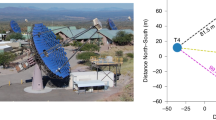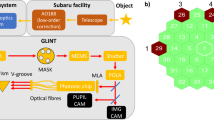Abstract
To determine the influence of the environment on star formation, we need to study the process in the extreme conditions of massive young star clusters (∼104 solar masses) near the centre of our own Galaxy1,2. Observations must be carried out in the near infrared because of very high extinction in visible light within the Galactic plane. We need high resolution to identify cluster members from their peculiar motions3, and because most such clusters span more than 1′, efficient observation demands a wide field of view. There is at present no space-based facility that meets all these criteria. Ground-based telescopes can in principle make such observations when fitted with ground-layer adaptive optics (GLAO)4,5,6, which removes the optical aberration caused by atmospheric turbulence up to an altitude of ∼500 m (refs 7–10). A GLAO system that uses multiple laser guide stars11,12,13 has been developed at the 6.5-m MMT telescope, in Arizona. In previous tests13, the system improved the resolution of the telescope by 30–50%, limited by wavefront error in the optics, but that was insufficient to allow rapid determination of cluster membership. Here we report observations of the core of the globular cluster M3 made after commissioning a sensor to monitor and remove slowly varying aberration in the optics. In natural seeing of 0.7′′, the point spread function at 2.2-μm wavelength was sharpened uniformly to 0.3′′ over a field of at least 2′. The wide-field resolution was enhanced by a factor of two to three over previous work13, with better uniformity, and extends to a wavelength of 1.2 μm. Entire stellar clusters may be examined in a single pointing, and cluster membership can be determined from two such observations separated by just one year14,15,16,17.
This is a preview of subscription content, access via your institution
Access options
Subscribe to this journal
Receive 51 print issues and online access
$199.00 per year
only $3.90 per issue
Buy this article
- Purchase on Springer Link
- Instant access to full article PDF
Prices may be subject to local taxes which are calculated during checkout


Similar content being viewed by others
References
McCrady, N., Graham, J. R. & Vacca, W. D. Mass segregation and the initial mass function of super star cluster M82-F. Astrophys. J. 621, 278–284 (2005)
Stolte, A., Brandner, W., Grebel, E. K., Lenzen, R. & Lagrange, A.-M. The Arches cluster: evidence for a truncated mass function? Astrophys. J. 628, L113–L117 (2005)
Cameron, P. B., Britton, M. C. & Kulkarni, S. R. Precision astrometry with adaptive optics. Astron. J. 137, 83–93 (2009)
Angel, J. R. P. & Lloyd-Hart, M. Atmospheric tomography with Rayleigh laser beacons for correction of wide fields and 30 m class telescopes. Proc. SPIE 4007, 270–276 (2000)
Rigaut, F. in Beyond Conventional Adaptive Optics (eds Vernet, E., Ragazzoni, R., Esposito, S. & Hubin, N.) 11–16 (Proc. ESO 58, European Southern Observatory, 2002)
Lloyd-Hart, M. et al. Experimental results of ground-layer and tomographic wavefront reconstruction from multiple laser guide stars. Opt. Exp. 14, 7541–7551 (2006)
Marchetti, E. et al. On-sky testing of the Multi-Conjugate Adaptive Optics Demonstrator. Messenger 129, 8–13 (2007)
Tokovinin, A. Seeing improvement with ground-layer adaptive optics. Publ. Astron. Soc. Pacif. 116, 941–951 (2004)
Martin, O. et al. Opto-mechanical commissioning of the GLAS Rayleigh laser guide star for the WHT. Proc. SPIE 7015, 70154N (2008)
Tokovinin, A. et al. SAM: a facility GLAO instrument. Proc. SPIE 7015, 70154C (2008)
Stalcup, T. et al. Field tests of wavefront sensing with multiple Rayleigh laser guide stars and dynamic refocus. Proc. SPIE 5490, 1021–1032 (2004)
Lloyd-Hart, M. et al. First tests of wavefront sensing with a constellation of laser guide beacons. Astrophys. J. 634, 679–686 (2005)
Baranec, C. et al. On-sky wide-field adaptive optics correction using multiple laser guide stars at the MMT. Astrophys. J. 693, 1814–1820 (2009)
Reid, M. J. et al. Trigonometric parallaxes of massive star-forming regions. VI. Galactic structure, fundamental parameters, and noncircular motions. Astrophys. J. 700, 137–148 (2009)
Stolte, A. et al. The proper motion of the Arches cluster with Keck laser-guide star adaptive optics. Astrophys. J. 675, 1278–1292 (2008)
Hußmann, B., Stolte, A. & Brandner, W. in Star Clusters: Basic Galactic Building Blocks throughout Time and Space (eds de Grijs, R. & Lépine, J. R. D.) 422 (Proc. Int. Astron. Union 5 Symp. S266, International Astronomical Union, 2010)
Schödel, R., Merritt, D. & Eckart, A. The nuclear star cluster of the Milky Way: proper motions and mass. Astron. Astrophys. 502, 91–111 (2009)
Andersen, D. et al. Performance modeling of a wide-field ground-layer adaptive optics system. Publ. Astron. Soc. Pacif. 118, 1574–1590 (2006)
Le Louarn, M. & Hubin, N. Improving the seeing with wide-field adaptive optics in the near-infrared. Mon. Not. R. Astron. Soc. 365, 1324–1332 (2006)
Wildi, F., Brusa, G., Lloyd-Hart, M., Close, L. & Riccardi, A. First light of the 6.5-m MMT adaptive optics system. Proc. SPIE 5169, 17–25 (2003)
Lloyd-Hart, M. Thermal performance enhancement of adaptive optics by use of a deformable secondary mirror. Publ. Astron. Soc. Pacif. 112, 264–272 (2000)
McCarthy, D., Ge, J., Hinz, J., Finn, R. & de Jong, R. PISCES: a wide field 1–2.5 micron camera for large aperture telescopes. Publ. Astron. Soc. Pacif. 113, 353–361 (2001)
Sasiela, R. J. Electromagnetic Wave Propagation in Turbulence: Evaluation and Application of Mellin Transforms 2nd edn, 164–172 (Springer Ser. Wave Phenomena, Springer. (1994)
Rabien, S. et al. The laser guide star program for the LBT. Proc. SPIE 7015, 701515 (2008)
Mandel, H. et al. LUCIFER: a NIR spectrograph and imager for the LBT. Astron. Nachr. 328, 626–627 (2007)
Acknowledgements
We thank the staff of the Steward Observatory Engineering and Technical Services division and the staff of the MMT Observatory for their support in the development and deployment of the MMT adaptive optics system. We are grateful to P. Strittmatter and R. Angel for reading the manuscript. The observations reported here were made at the MMT Observatory, a joint facility of The University of Arizona and the Smithsonian Institution. The work has been supported by the National Science Foundation.
Author information
Authors and Affiliations
Contributions
M.H. wrote the paper. N.M.M., C.B., M.H. and E.B. carried out the data reduction. N.M.M. designed the adaptive optics reconstructor matrices. K.P. analysed the real-time system performance. T.S. designed and built the laser launch optics and wrote the system’s operating software. D.M. and C.K. operated the infrared camera that recorded the cluster images at the telescope. All authors took part in the telescope runs during which the data presented here were acquired.
Corresponding author
Ethics declarations
Competing interests
The authors declare no competing financial interests.
PowerPoint slides
Rights and permissions
About this article
Cite this article
Hart, M., Milton, N., Baranec, C. et al. A ground-layer adaptive optics system with multiple laser guide stars. Nature 466, 727–729 (2010). https://doi.org/10.1038/nature09311
Received:
Accepted:
Issue Date:
DOI: https://doi.org/10.1038/nature09311
Comments
By submitting a comment you agree to abide by our Terms and Community Guidelines. If you find something abusive or that does not comply with our terms or guidelines please flag it as inappropriate.



